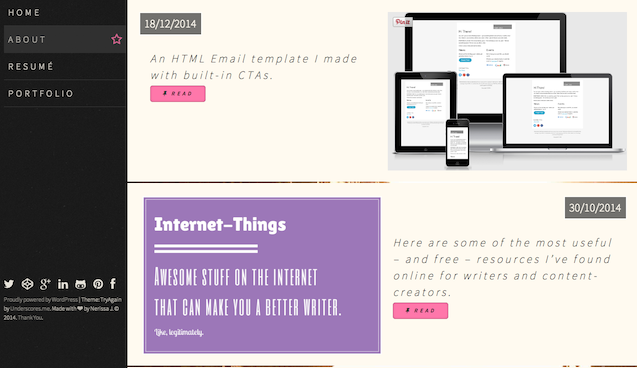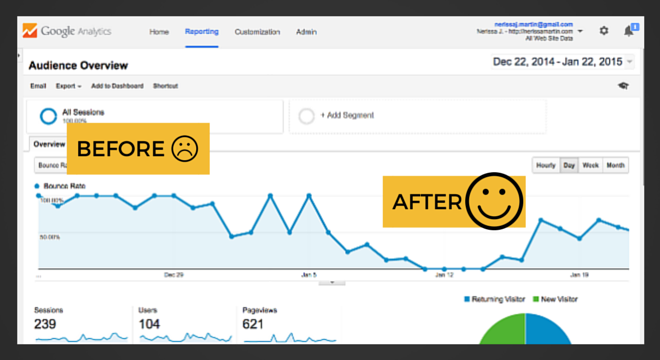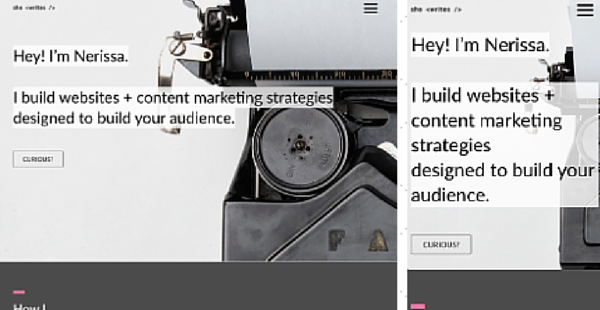How to know when to rebrand + redesign your website.
A couple weeks ago, I attended a webinar for the Content Management Institute on website rebranding and redesign. It was an apt topic for me because I spent pretty much the whole Christmas break this past year on rebranding and redesigning my own site.
It’s strategy that wins wars… You have to have your website strategy clearly in mind before kicking off any redesign or rebrand project. Know what you want your new website to do.
– Lou Jordano (CMO, Ektron)

Here’s some points on how I knew it my site needed to be redone. Hopefully something here can help you decide if you need to overhaul your own website, but if not, you’ll find four more reasons to rebrand your site below.
1. I knew I would still have to explain ‘what I do’ to anyone who visited.
While I was building the site, a part of me was getting mentally prepared to explain to people what I did. I knew that visiting the site wouldn’t explain everything right off the bat (hence the site I have now :)). I wanted my site to be all about my blog, so having it front and centre seemed to make sense. But my site wasn’t built to just be a blog, it’s basically the centre of everything I do, so it needed to be more than just a place I could list posts.
Being the core of my business, you would think the ‘About’ section (or information) would be essential. But on my old site it was literally a bunch of images that didn’t really say anything. Talk about a missed opportunity.
2. The bounce rate was ridiculously high, like 99.999%.
This is perhaps the biggest reason I know the redesign worked. After redo, the bounce rate dropped significantly. Granted, my site is more or less one page, but compared to other similar sites, the bounce rate is right where it should be.

3. The site was inconsistent with who I was / what I did.
I wanted to include everything on the site – I’d gone to school a bunch of times, wrote a book and sang on the side. I wanted the site to have all that stuff in it but after a meeting with Heather, CEO @ HackerYou, I realized that in throwing everything on my site I had made a messaging-mess.
Rebranding gave me the opportunity to think of more creative ways to say what I wanted to. For example, using the typewriter image as the background for the first section. I also thought of blog post ideas and other ways I could use content to talk about music and writing.
4. I knew I would have to rebrand / redesign the site halfway through completing it.
This point speaks more to paying attention to your intuition. While I was building the site, I knew I would have to redo it. By the time this dawned on me I was halfway through, so throwing everything away didn’t even cross my mind.
I figured I would stay on track and that the finished product would be a kind of ‘holding page’ to just have ‘something up there’ until I got a real site. Except it wasn’t. I was spending hours on it, much more time than should have been if its purpose was really only temporary.
Sure I learned some new things and put my fresh HackerYou skills to use, but I was too far deep in building the site to get any perspective. This is where I learned the lesson of having a vision for your site.

Do You Need To Rebrand / Redesign Your Website?
I’m going to resist the urge to find every outdated / ugly site online and just post links with a full description of what they’re doing wrong. We’ve all seen a site that could use a refresh; doing that would be what the kids call “a read”. So here are four more reasons you may need to rebrand or redesign your site:
1. Your site was built more than three years ago and hasn’t been touched ever since.
A lot has happened in web development over the last few years. If you’re website is more than three years old and it hasn’t been updated, it’s time to look at how those developments can get you paid.
2. Your business has gone through some major changes.
Is there stuff on your site that is no longer relevant to you or your business? Do customers continually ask you for products or expect certain things because they ‘saw it online’? The solution is simple: update your site!
Use the opportunity to educate your current / potential customers and clients about your business. You’ll spend less time answering questions and more time making money.
3. You’re getting not-so-great feedback about the site, its features and / or functions.
If you’re getting unsolicited feedback on your site, consider it a gift. Most of the time visitors to your site will keep their [sometimes very valuable] opinions to themselves. But they’ve got insights, those silent witnesses. They have reactions to the way your site looks and how it works, and this information is probably exactly what you need to improve UI / UX.
Why not ask someone their opinion of your site, or send out a survey to a select group of customers / clients? Think of it as an opportunity to build a relationship and be prepared to offer them something in return.

4. You want to, or are getting ready to, rebrand your business.
You’re lucky if you’re getting ready to make some changes to your business. Your website hasn’t been re-touched yet so in some ways you and your business are “starting fresh”.
While you’re considering rebranding your business, think about ways you could potentially update your website. You might want to reach out to a content marketing or development expert to ask about potential opportunities to update your site in a way that will be consistent with your new brand.
Conclusion
Websites are never finished only abandoned. You and your developer could spend the rest of your lives redesigning, rebranding, retooling, rewriting.
Having some guidelines can help you and your team decide how updates should be made, if they should be made. On a basic level, the changes to your site should follow the flow of your business. Rebrand your site if and when your business changes or people important to your business are telling you a redo is needed.

